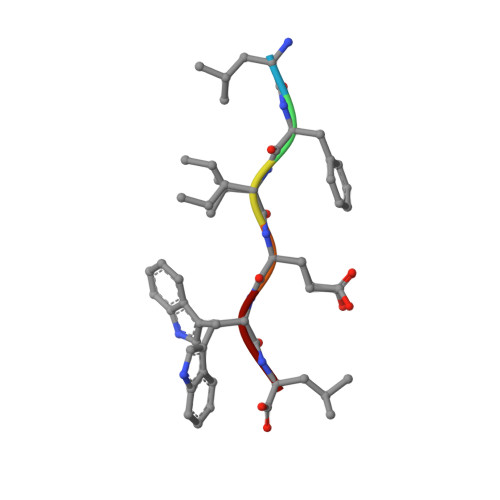Polymorphic amyloid nanostructures of hormone peptides involved in glucose homeostasis display reversible amyloid formation.
Horvath, D., Durvanger, Z., K Menyhard, D., Sulyok-Eiler, M., Bencs, F., Gyulai, G., Horvath, P., Taricska, N., Perczel, A.(2023) Nat Commun 14: 4621-4621
- PubMed: 37528104
- DOI: https://doi.org/10.1038/s41467-023-40294-x
- Primary Citation of Related Structures:
8ANG, 8ANH, 8ANI, 8ANJ, 8ANK, 8ANL, 8ANM, 8ANN, 8ONQ - PubMed Abstract:
A large group of hormones are stored as amyloid fibrils in acidic secretion vesicles before they are released into the bloodstream and readopt their functional state. Here, we identify an evolutionarily conserved hexapeptide sequence as the major aggregation-prone region (APR) of gastrointestinal peptides of the glucagon family: xFxxWL. We determine nine polymorphic crystal structures of the APR segments of glucagon-like peptides 1 and 2, and exendin and its derivatives. We follow amyloid formation by CD, FTIR, ThT assays, and AFM. We propose that the pH-dependent changes of the protonation states of glutamate/aspartate residues of APRs initiate switching between the amyloid and the folded, monomeric forms of the hormones. We find that pH sensitivity diminishes in the absence of acidic gatekeepers and amyloid formation progresses over a broad pH range. Our results highlight the dual role of short aggregation core motifs in reversible amyloid formation and receptor binding.
Organizational Affiliation:
ELKH-ELTE Protein Modeling Research Group ELTE E?tv?s Lor¨¢nd University, P¨¢zm¨¢ny P¨¦ter s¨¦t¨¢ny 1/A, Budapest, H-1117, Hungary.














